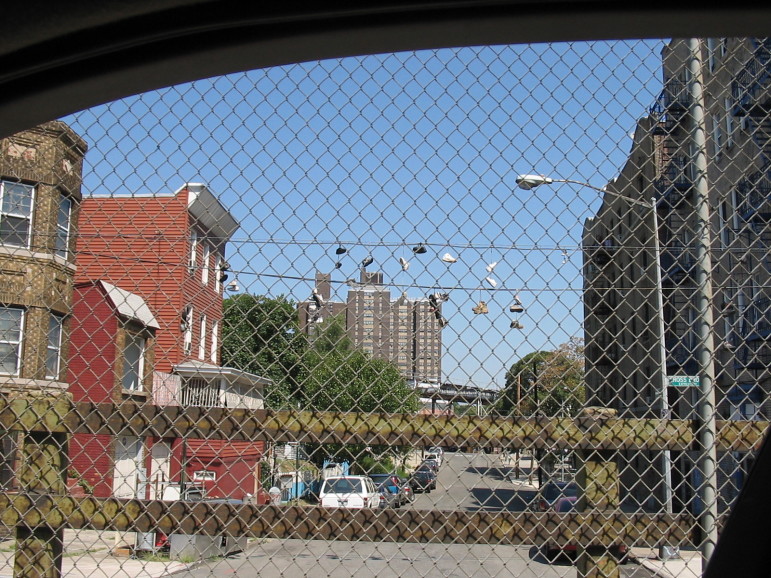
WikiWiki718
A street scene in the West Farms area of the Bronx. Far from the tide of gentrification, the area is part of a swath of the borough that has seen massive increases in rent.
The financial crisis of 2008 is old news – unless you are a New Yorker whose income is below 200 percent of the federal poverty line, a typical cut-off point for the “near poor.” The median household in that group is paying 49 of its income toward rent. A report by the Community Service Society of New York out Tuesday says that’s because incomes have yet to recover from the crash, while rents have risen in good years and bad.
The stats are startling but the idea that New York City is in the midst of a huge housing crisis is certainly not news. After all, housing and affordability dominates political debate. Often, that discussion focuses on particular neighborhoods that are being reshaped by gentrification.
But CSS raises an important question: Could that focus be missing a bigger picture?
The rate of increase of rents does vary by neighborhood, and some of the neighborhoods with the highest rates of increase are the same ones undergoing local redevelopment and highly visible social change, like Bedford Stuyvesant and Central Harlem. But the current emphasis on gentrification and redevelopment should not blind us to the intensifying rent pressures experienced in a wide variety of places. An increasing number of low-income, unassisted tenants are paying more than half their income in rent in most parts of the city, including gentrifying neighborhoods in Brownstone Brooklyn and Upper Manhattan, historic high-income areas of Manhattan, and persistent poverty centers in central Brooklyn and the central Bronx.
That citywide pressure is reflected in the declining number of units in the rent-stabilization program, which CSS (a City Limits funder) notes is the largest single source of affordable units.
And the shrinking of the rent-stabilized portfolio is due largely to the effect of the vacancy allowance (a.k.a. “eviction bonus”), which “allows an automatic increase of about 20 percent when an apartment becomes vacant and turns over to a new tenant,” the report finds. “This mechanism explains 49 percent of the citywide total increase in stabilized rents above inflation” from 2002 to 2014. Hikes in stabilized rent and the phenomenon of preferential rent have also taken their toll.
CSS’s policy prescriptions are simple: The Rent Guidelines Board should maintain the approach seen during the last two years of freezing rents or permitting only modest hikes. And state policymakers should move to eliminate the vacancy allowance and prevent landlords from suddenly withdrawing preferential rents to trigger massive increases in what a tenant pays.
Also on Tuesday, Enterprise Community Partners, Inc. and LiveOn issued findings on the operation of the Senior Citizen Rent Increase Exemption (SCRIE) program that found the program was failing to reach most seniors and failing to adequately protect many of those who are enrolled.
“Currently, only an estimated 43 percent of eligible seniors are enrolled in SCRIE, and since rents are frozen at the level the senior was paying when they entered the program, almost one third of SCRIE participants pay more than 70 percent of their income on rent,” the report found.
“Unless we intervene now, the number of elderly New Yorkers paying unsustainable levels of rent will continue to skyrocket, with disastrous impacts for seniors and our communities,” the authors wrote.








4 thoughts on “City’s Housing Crisis is Bigger than Gentrification: Report”
You have a point about rents going up all over the city. Even here in far-off Staten Island the median rent is in the $2k/month range.
The RGB sets rent increases assuming that landlords get a vacancy bonus every 6th year or so.
Eliminating vacancy bonuses would cause rents for current tenants to rise faster than they do now.
DUH CITY LIMITS YOU ARE SUCH OLD GEEZERS i told you and everyone else
about this 10 years ago……… just find the dumbest tenants students recently divorced and you can easily tun a $500 apt into $1500 legally……..just never rent to people who want a stable place
to live…………lke meeee!!!!!
there is a ton of incentives to put in a $3000 viking pro chefs oven in a 6th floor walkup instead of a $300 one from sears!
We once saw a jacuzzi in a small 1-br. Still waiting for a LL to nail a bunch of gold bricks to the wall.